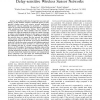Free Online Productivity Tools
i2Speak
i2Symbol
i2OCR
iTex2Img
iWeb2Print
iWeb2Shot
i2Type
iPdf2Split
iPdf2Merge
i2Bopomofo
i2Arabic
i2Style
i2Image
i2PDF
iLatex2Rtf
Sci2ools
GLOBECOM
2008
IEEE
2008
IEEE
Multi-Cluster Multi-Parent Wake-Up Scheduling in Delay-Sensitive Wireless Sensor Networks
—Immediate notification of urgent but rare events and delivery of time sensitive actuation commands appear in many practical wireless sensor and actuator network applications. Multi-parent wake-up scheduling was presented as a technique which can provide bi-directional end-to-end latency guarantees while optimizing the node battery lifetime. This method takes a cross-layer approach where multiple routes for transfer of messages and wake-up schedules for nodes are crafted in synergy to reduce overall message latencies. In this paper, we generalize the multi-parent method to support a multi-cluster model for the network where we assume that the network has multiple central points called cluster-head (CH) that are in charge of scheduling the nodes in the network. A key step in multi-parent method is to divide the nodes in network into disjoint groups such that each node has at least one link to a node in each group. We formulate this step as a graph coloring problem which is shown to b...
GLOBECOM 2008 | Multi-parent Method | Multi-parent Wake-up Scheduling | Node Battery Lifetime | Telecommunications |
| Added | 29 May 2010 |
| Updated | 29 May 2010 |
| Type | Conference |
| Year | 2008 |
| Where | GLOBECOM |
| Authors | Huang Lee, Abtin Keshavarzian, Hamid K. Aghajan |
Comments (0)

